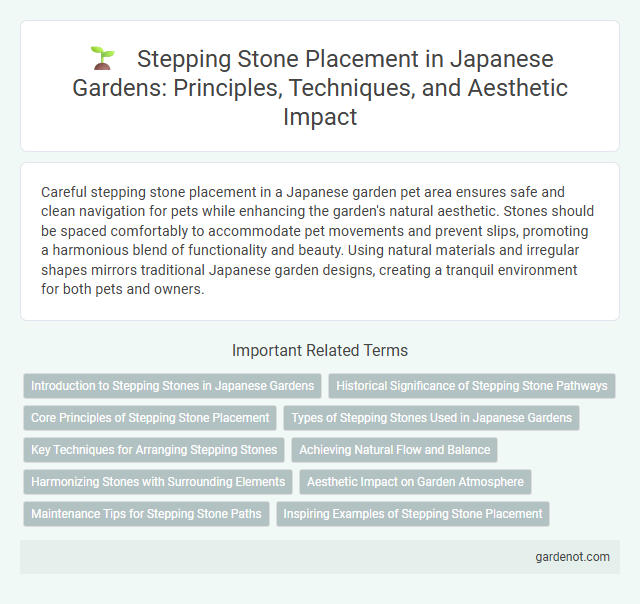Careful stepping stone placement in a Japanese garden pet area ensures safe and clean navigation for pets while enhancing the garden's natural aesthetic. Stones should be spaced comfortably to accommodate pet movements and prevent slips, promoting a harmonious blend of functionality and beauty. Using natural materials and irregular shapes mirrors traditional Japanese garden designs, creating a tranquil environment for both pets and owners.
Introduction to Stepping Stones in Japanese Gardens
Stepping stones in Japanese gardens serve both functional and aesthetic purposes, guiding visitors through the space while enhancing the natural flow of the landscape. Typically made of natural materials like granite or slate, these stones are carefully spaced to encourage mindful walking and a harmonious connection with the surroundings. This traditional placement reflects principles of wabi-sabi, emphasizing simplicity and the beauty of imperfection.
Historical Significance of Stepping Stone Pathways
Stepping stone pathways in Japanese gardens trace their origins to the Heian period, symbolizing a mindful journey through nature while guiding visitors with deliberate, asymmetrical placement that mirrors natural landscapes. These stones often represent spiritual steps or the passage between different realms, reflecting Buddhist and Shinto influences embedded in traditional garden design. Their historical significance lies in promoting contemplation and harmony, enhancing the garden's role as a meditative space aligned with cultural aesthetics.
Core Principles of Stepping Stone Placement
Stepping stone placement in Japanese gardens follows core principles emphasizing natural flow, balance, and purpose. Stones are positioned to guide visitors smoothly through the landscape, mimicking natural paths and encouraging mindful movement. Proper spacing considers stride length and visual harmony, enhancing both aesthetic appeal and functional navigation.
Types of Stepping Stones Used in Japanese Gardens
Japanese gardens feature various types of stepping stones including flat stones, irregular natural stones, and carved granite, each chosen to enhance aesthetic appeal and guide visitors through the landscape. Flat stones provide stable footing along pathways, while irregular natural stones create a sense of organic flow and connection to nature. Carved granite stones often serve as focal points or accents, highlighting key areas within the garden's design.
Key Techniques for Arranging Stepping Stones
Key techniques for arranging stepping stones in a Japanese garden emphasize natural placement, irregular spacing, and varying shapes to mimic organic patterns found in nature. Proper alignment ensures a slow, mindful walking pace, enhancing the garden's meditative atmosphere. Using stones with contrasting textures or colors highlights pathways while maintaining harmony with surrounding plants and elements.
Achieving Natural Flow and Balance
Stepping stone placement in a Japanese garden emphasizes achieving a natural flow and balance by mimicking the organic patterns found in nature, carefully spacing stones to guide visitors smoothly along the path. Stones of varying sizes and shapes are staggered thoughtfully to promote mindful walking and enhance the garden's harmonious rhythm. This intentional arrangement fosters a seamless connection between the pathway and surrounding elements, creating a tranquil and immersive experience.
Harmonizing Stones with Surrounding Elements
Stepping stone placement in a Japanese garden emphasizes harmonizing stones with surrounding elements to create a natural, balanced flow. Stones are carefully chosen for size, shape, and texture to complement moss, plants, and water features, enhancing the garden's tranquil ambiance. Proper alignment ensures movement feels intuitive, guiding visitors while maintaining the garden's aesthetic unity.
Aesthetic Impact on Garden Atmosphere
Stepping stone placement in a Japanese garden enhances the aesthetic impact by guiding the viewer's gaze and creating a natural flow that complements the surrounding landscape. Carefully spaced stones mimic the irregularity found in nature, fostering a sense of tranquility and mindfulness as visitors move through the space. This arrangement not only emphasizes harmony between elements but also adds depth and texture, enriching the overall garden atmosphere.
Maintenance Tips for Stepping Stone Paths
Stepping stone placement in Japanese gardens requires careful alignment to ensure both aesthetic harmony and safety. Regularly inspect the stones for stability and remove debris to prevent moss buildup, which can cause slipperiness. Use gravel or sand underneath to improve drainage and maintain evenness, reducing the risk of stones shifting over time.
Inspiring Examples of Stepping Stone Placement
Stepping stone placement in Japanese gardens often reflects principles of asymmetry and natural flow, creating a pathway that encourages mindful walking and contemplation. Renowned gardens such as Ryoan-ji and Saiho-ji feature stones arranged irregularly to mimic natural riverbeds, enhancing the visual and tactile experience. These placements emphasize harmony with the surrounding landscape, guiding visitors through tranquil spaces while highlighting the garden's seasonal beauty.
Stepping stone placement Infographic

 gardenot.com
gardenot.com